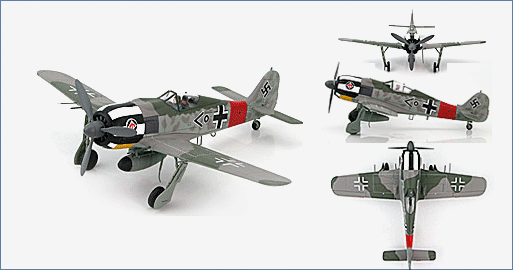Air Power Series>1:48 die-cast display model>FW-190>HA7418
FW-190 A7 Stab I./JG 1, flown by Oblt. Wilhelm Krebs,
Dortmund Airfield, Jan. 1944

General Background
In 1937 the Me-109 was an excellent aircraft but the Reich Air Ministry wanted a new advanced fighter that could out perform any future foreign designs. Kurt Tank’s Focke-Wulf Fw-190 Würger (Butcher Bird) won the design competition by using an air-cooled radial engine. When the Fw-190 entered combat in the summer of 1941 it already was Germany’s premiere piston-powered WWII fighter. Over 20,000 of all variants of the Fw-190 were built with 13,291 of these being of the 9 different “A” variants.
The Aircraft
1/JG 1 was formed in May of 1939 as one of the original Jagdeschwaders. Between 1940
and 1944 the unit was equipped with Messerschmitt Bf-109 and Fw-190s. I/JG 1 was the
only unit to be equipped with the Heinkel He-162 jet and the first to attempt aerial bombing of
the USAAF heavy bomber formations. In 1944 the "Oeseau" was added to JG 1 when
Geschwaderkommodore Oberst Walter Oeseau was killed. This aircraft belonged to Oblt.
Wilhelm Krebs; Group Technical Officer for Stab 1/JG1 and credited with 4 B-17s.
Specifications :
| Dimensions: | Wingspan – 10.5 m (34 ft 5 in) |
| Wing Area – 18.3 m (197 sq ft) | |
| Length – 8.96 m (29 ft 5 in) | |
| Height – 3.96 m (13 ft) | |
| Weight: | Empty – 3,470 kg (7,650 lb) |
| Maximum – 4,900 kg (10,800 lb) | |
| Performance: | Engine – BMW 801D 1,700 hp 14-cylinder radial engine |
| Maximum Speed – 657 kph (408 mph) (335 kts) | |
| Service Ceiling – 10,300 m (33,800 ft) | |
| Range – 800 km (500 mi) (435 nmi) | |
| Armament: | (2) 13 mm Machine Guns plus |
| (4) 20 mm cannon or | |
| (2) 20 mm cannons plus | |
| (2) 30 mm cannons |

